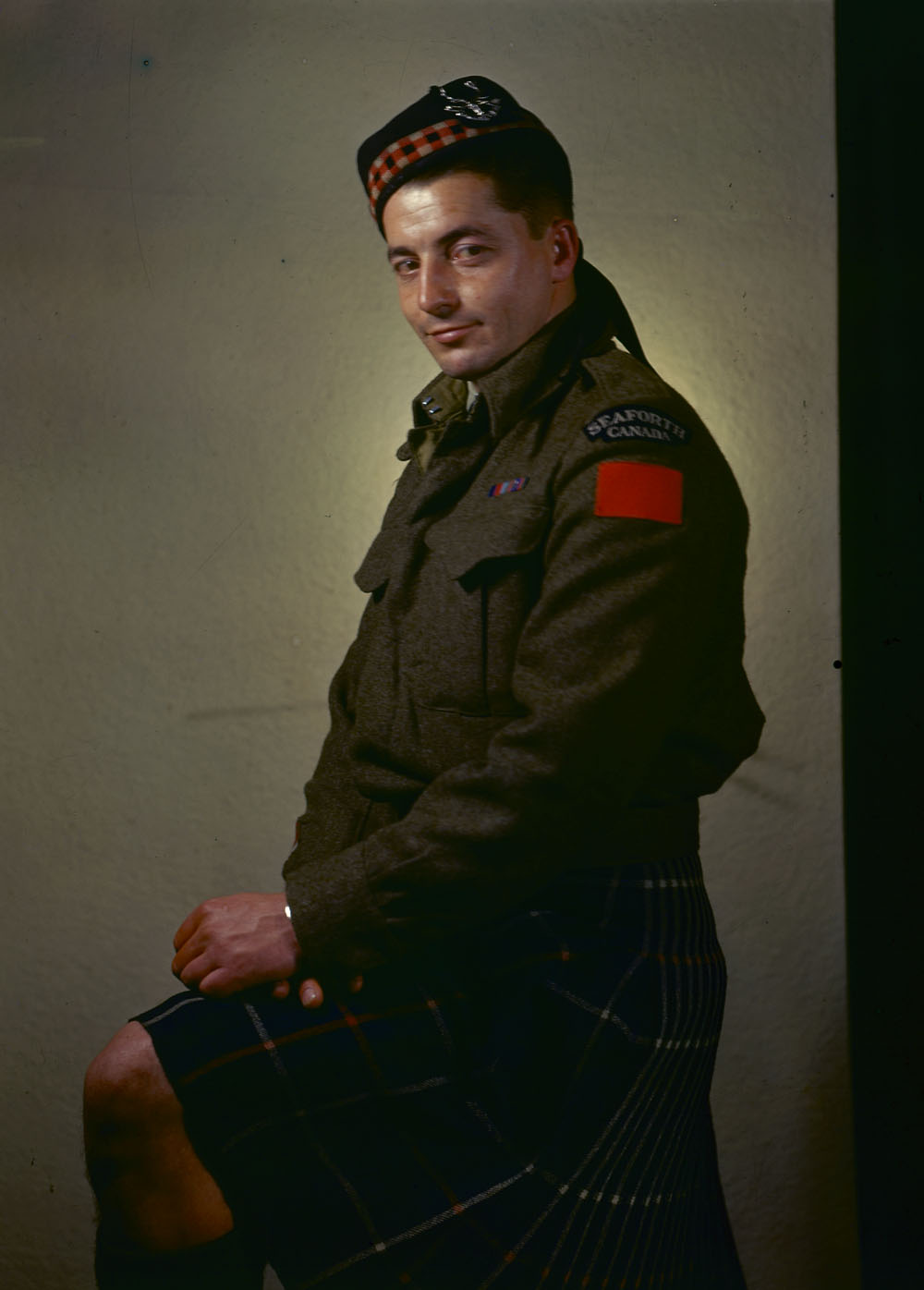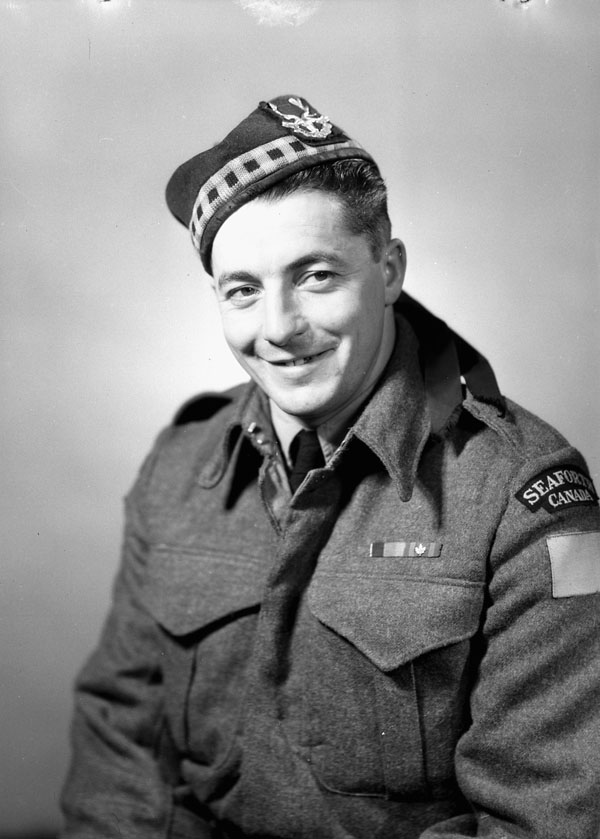Ernest Alvia “Smokey” Smith, VC, OC, OBC, soldier, businessman (born 3 May 1914 in New Westminster, BC; died 3 August 2005 in Vancouver). Smith was one of 16 Canadian recipients of the Victoria Cross (VC) during the Second World War and the only private soldier to earn the award. Before his death in 2005, he was the last living Canadian recipient of the VC.

Early Life
Smokey Smith was one of two sons of a teamster father. He attended Herbert Spencer Elementary School and the T.J. Trapp Technical School in New Westminster, British Columbia. Smith played various sports and excelled at sprinting, basketball, football and lacrosse, where his speed earned him the nickname “Smokey.” On completion of his education, Smith worked for a building contractor.
Second World War
Smokey Smith enrolled in the Seaforth Highlanders of Canada in March 1940 and underwent basic training in Toronto and Camp Borden, Ontario. He sailed to Britain in July, where the Seaforths had been stationed since December 1939 as part of 2nd Brigade, 1st Canadian Infantry Division. Smith spent the next three years training in Britain.
For Smith and the soldiers of 1st Division, the Allied invasion of Sicily, known as Operation Husky, began just after dawn on 10 July 1943. (See Canada and the Italian Campaign.) Following successful seaborne assault landings, the Seaforths advanced steadily across the island in the face of strong German opposition. By 18 August, the entire island was in Allied hands. During the campaign, the Seaforths suffered 190 wounded, including Smith, who was wounded twice.
Heroism at the Savio River
In the following months, the Allies undertook a gruelling advance up the Italian boot as they slowly pushed the Germans back. Late October 1944 found the Canadians at the Savio River in northern Italy. On the night of 21 October, Smokey Smith’s company crossed the Savio, along with another Seaforth company. The two companies seized a narrow bridgehead and waited for armour reinforcements to arrive. But heavy rain had caused the river to rise almost two metres and become a raging torrent. Canadian tanks and antitank guns were unable to cross and provide support.
Early the next morning, three Panther tanks, two self-propelled guns and about 30 German soldiers attacked the right flank of the small bridgehead. Smith was in charge of a two-man antitank team armed with PIATs (Projector, Infantry, Anti-Tank). The PIAT was a simple but cumbersome antitank weapon and was only effective when used at 90 metres or less.
Smith and his colleagues crossed an open field and set up in a ditch beside the road the tanks were using. When machine-gun fire from the tanks badly wounded one of Smith’s teammates, he stood up and fired his PIAT from approximately nine metres, which stopped the Panther. About 10 German infantrymen leapt from the tank and charged toward Smith, firing their machine guns and throwing grenades. Smith immediately jumped onto the road, shot four of the enemy and drove the rest back.
A second Panther now attacked but remained out of PIAT range while other German soldiers opened fire in support. Smith held his position to protect his wounded comrade and fired on the enemy with some abandoned machine gun magazines he found in a ditch. In the face of his dogged defence, the Germans withdrew.
By then, one tank and both self-propelled guns had been destroyed, but another tank opened fire from a longer range. Smith got his wounded comrade to safety and obtained medical aid for him. He then returned to his former position next to the road to await a further attack. When none came, the rest of the Seaforths were able to cross the Savio River and consolidate the bridgehead.
As a result of Smith’s “dogged determination, outstanding devotion to duty and superb gallantry …his comrades were so inspired that the bridgehead was held firm against all enemy attacks.” For this action, King George VI invested Smith with the VC at Buckingham Palace on 18 December 1944.
Smith had a well-earned reputation as a hellraiser and insubordinate soldier who did not like taking orders. During the war, he was promoted to corporal nine times, but his behaviour resulted in his demotion back to private on each occasion. The night before he flew to England to receive his VC, he was confined in a jail cell in Naples to “keep him out of trouble.” His guards provided him with a couple of beers, which Smith later noted made him “very happy.”
When the Canadians were transferred from Italy to northwest Europe in early 1945, Smith was home on leave and therefore missed the final battles of the war.

Life Postwar
Smokey Smith returned to civilian life after the war and initially worked for a photographic studio. He married his wife, Esther Weston, in 1947 and they had a daughter and a son. Smith rejoined the army in 1951 after the Korean War broke out but did not serve overseas. Instead, he worked in the Tri-Service Recruiting Unit and the British Columbia Area Headquarters of Western Command, both in Vancouver. Smith retired as a sergeant in 1964.
In retirement, Smith and his wife ran a successful travel agency in Vancouver, where he became actively involved in his community. He was appointed a Member of the Order of Canada in 1995 for his longtime support of commemorative events and ceremonies around the world, as well as “a champion of the rights and memories of veterans.” In 2002, Smith was also made a member of the Order of British Columbia.
After he died, Smith’s cremated remains lay in state in the Centre Block of Ottawa’s Parliament Building, an honour previously granted to only a few prominent Canadians. Smith’s ashes were then returned to the Seaforth Armouries in Vancouver to lie in state again before his funeral on 13 August. In accordance with his wishes, his ashes were scattered at sea, a duty carried out from the frigate HMCS Ottawa.

 Share on Facebook
Share on Facebook Share on X
Share on X Share by Email
Share by Email Share on Google Classroom
Share on Google Classroom





